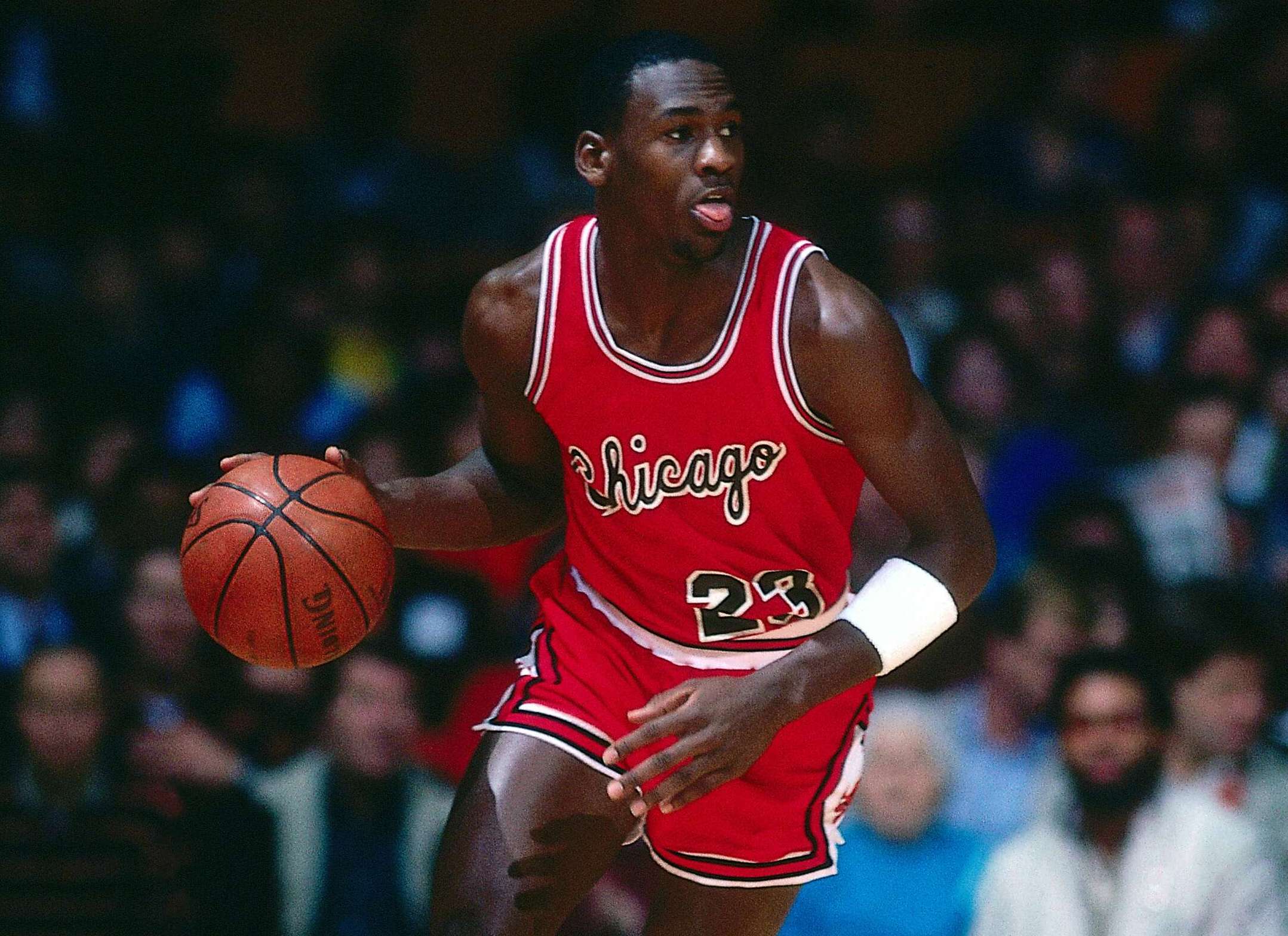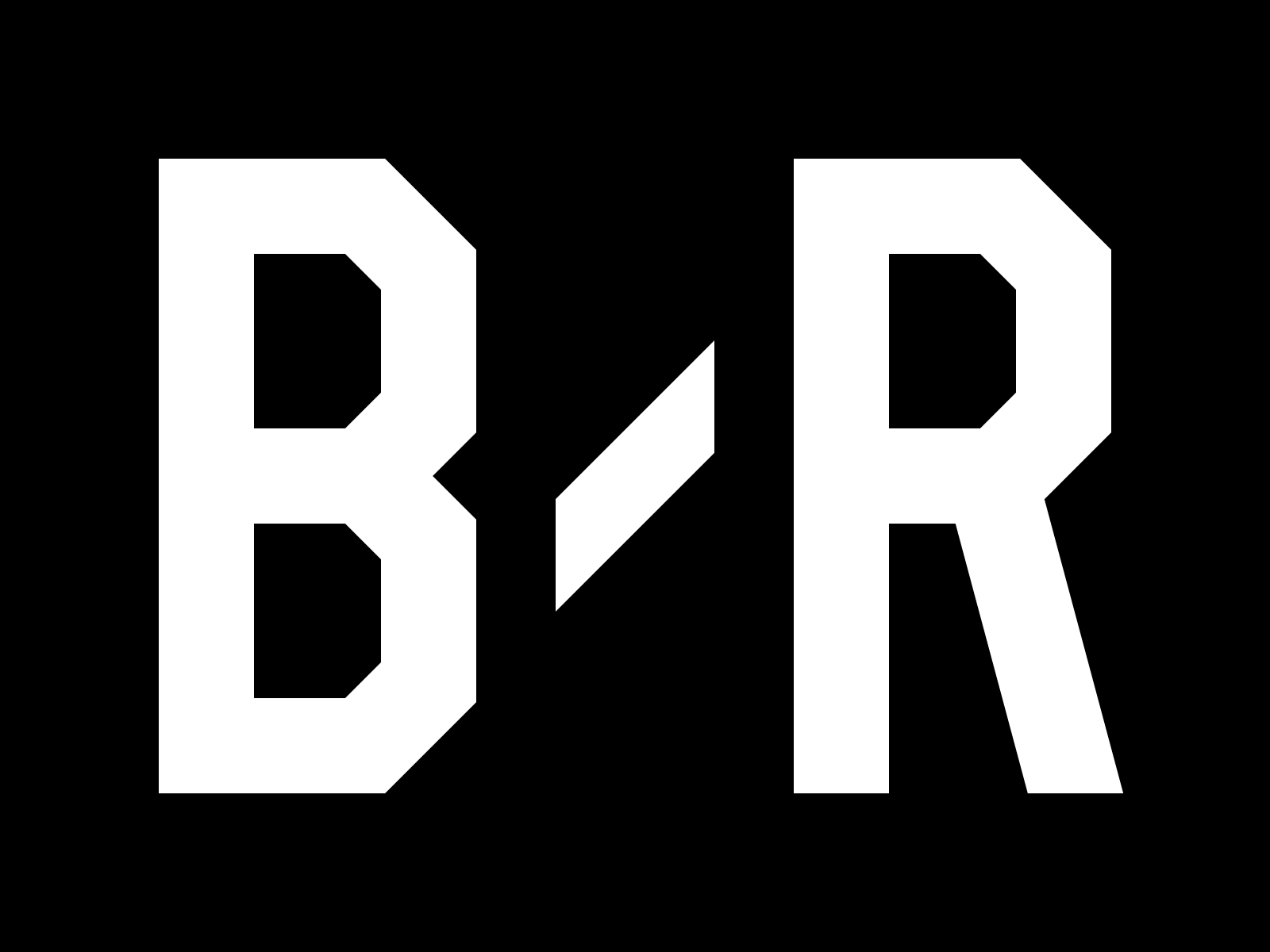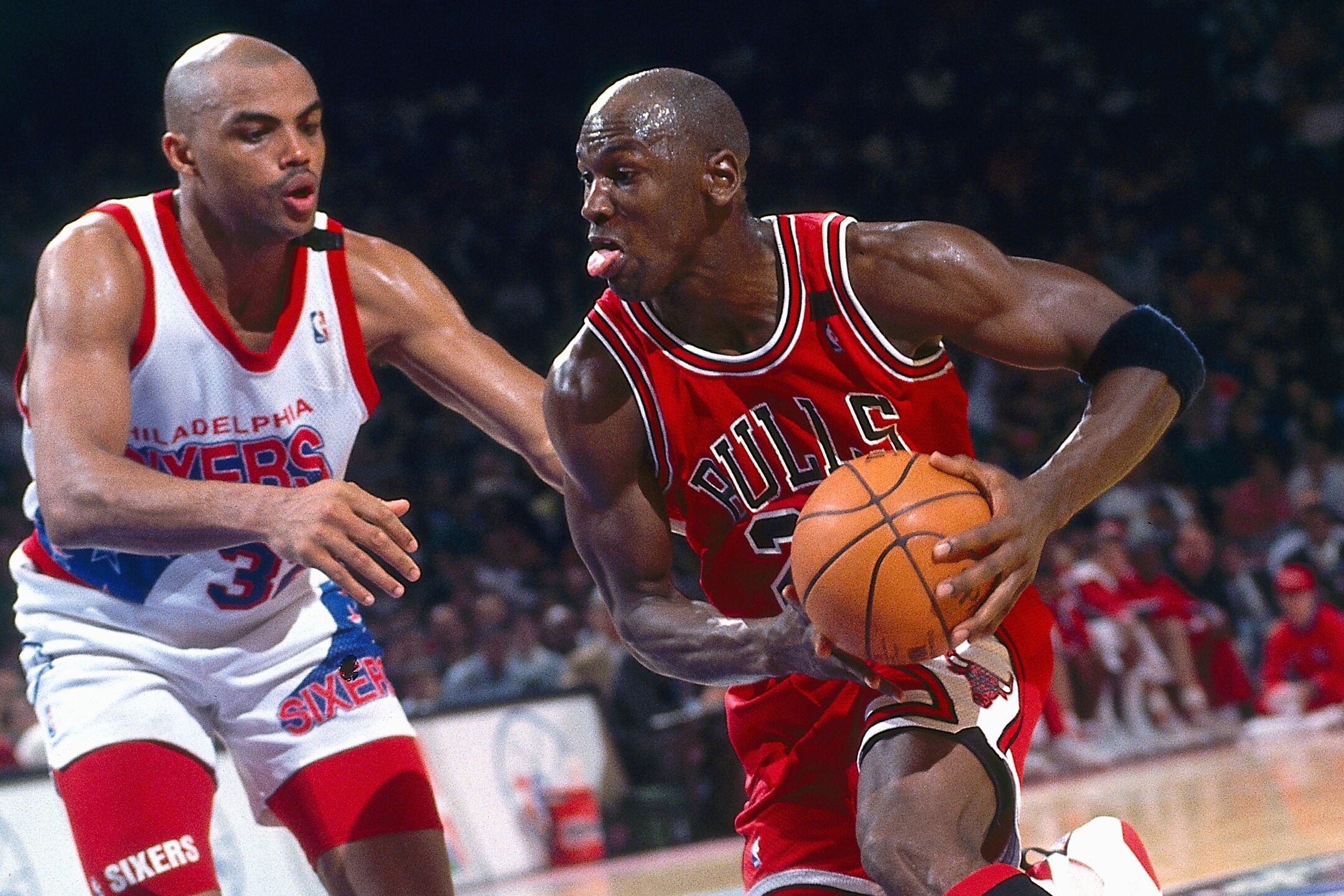The 1984 NBA draft is typically considered the greatest of all time, highlighted by four Hall of Famers.
While Michael Jordan remains the headliner, Hakeem Olajuwon, John Stockton and Charles Barkley would have made for a historically great class by themselves.
This was also the last draft that was conducted without a lottery, with previous drafts from 1966 to 1984 relying on a coin-flip system that was changed because of the Houston Rockets' supposed (and successful) tanking in an effort to get the No. 1 pick and draft Olajuwon.
The event was also far different than it is today, with only 24 teams but 10 rounds of selections.
With seven All-Stars sprinkled in—and a future NBA head coach in Rick Carlisle—there's never been as deep or star-studded of a draft class as 1984's. With the benefit of hindsight, we know Jordan would go first, but how would the other Hall of Famers and remainder of the first round shake out?
1. Houston Rockets: Michael Jordan, UNC

While the Houston Rockets originally got one of the greatest centers of all time in Olajuwon here, no one would pass on Jordan if given a second chance.
MJ is a six-time champion, six time Finals MVP, five-time league MVP, 10-time scoring champion and 14-time All-Star.
Widely considered the greatest player in history, Jordan put up 28.2 points per game as a rookie and never looked back. His lifetime average of 30.1 points per game is the highest in NBA history, topping out at 37.1 in his third season.
Jordan was an all-world defender as well, making nine All-Defensive teams and winning Defensive Player of the Year in 1987-88.
Even knowing he would retire three times throughout his career, the Rockets take Jordan at No. 1 in a no-brainer.
Actual Pick: Hakeem Olajuwon
Jordan's Actual Draft Slot: No. 3, Chicago Bulls
2. Portland Trail Blazers: Hakeem Olajuwon, Houston
After passing on Jordan for Sam Bowie the first time around, the Portland Trail Blazers don't even get the chance to land MJ here.
Still, Olajuwon is a darn good consolation prize and a major upgrade over their original pick in 1984.
Olajuwon is arguably the greatest center of all time, playing 18 seasons while making 12 All-Star Games and nine All-Defensive teams, and winning two Defensive Player of the Year awards (1993 and 1994).
Picking Olajuwon over Barkley and Stockton comes down to his dominance on both ends and his ability to carry a team to a championship. The Houston Rockets won titles in 1994 and 1995 with Olajuwon as the centerpiece, as twice he won Finals MVP.
Actual Pick: Sam Bowie
Olajuwon's Actual Draft Slot: No. 1, Houston Rockets
3. Chicago Bulls: Charles Barkley, Auburn
The Chicago Bulls automatically become the losers of this re-draft with Jordan off the board, although they still have two Hall of Famers to choose from.
Stockton would be an excellent pick here as well, but Barkley's peak was just a little higher than the Gonzaga point guard's.
Barkley was the league's MVP in 1992-93, even beating out Jordan for the award. He averaged at least 20 points and 10 rebounds per game for 11 straight seasons, leading the NBA with 14.6 boards per contest in 1986-87.
An 11-time All-Star and All-NBA team member, Barkley is a top-five power forward of all time, one of the best rebounders in league history and more than worthy to be the first overall pick...just not in a draft with Jordan and Olajuwon.
Actual Pick: Michael Jordan
Barkley's Actual Draft Slot: No. 5, Philadelphia 76ers
4. Dallas Mavericks: John Stockton, Gonzaga
No offense to Sam Perkins, but the Dallas Mavericks blew this pick and the opportunity to pair Stockton with Dirk Nowitzki for five seasons in the late 1990s and early 2000s.
Stockton played 19 seasons in the NBA, finishing second to Jordan in the 1984 draft class in total win shares (207.7) and value over replacement player (106.5). A 10-time All-Star, Stockton helped lead the Jazz to the playoffs every year for nearly two decades.
A top-five point guard of all time, Stockton hasn't just broken records, he's shattered them. His 15,806 career assists are 3,715 ahead of second-place Jason Kidd. For comparison, 34-year-old Chris Paul is only about 61 percent of the way to Stockton's career assist total.
Stockton is also the NBA's all-time leader in steals (3,265), or 581 more than Kidd's second-place total.
Stockton's assist and steals records should stand for a long, long time.
Actual Pick: Sam Perkins
Stockton's Actual Draft Slot: No. 16, Utah Jazz
5. Philadelphia 76ers: Kevin Willis, Michigan State
Kevin Willis began his career playing against Kareem Abdul-Jabbar and finished it defending LaMarcus Aldridge.
That's longevity.
Willis was 44 when he retired for good, although simply praising his lasting power in the league overshadows how good his prime was.
A 7'0" mountain of pure muscle, Willis made the 1992 All-Star Game by averaging 18.3 points and 15.5 rebounds per game for the Atlanta Hawks. He averaged a double-double for five seasons and finished his 21 years with 12.1 points and 8.4 rebounds per contest, winning a ring with the San Antonio Spurs in 2003.
While he didn't have the career of the four Hall of Famers taken above him here, Willis is still worthy of a top-five pick in this re-draft.
Actual Pick: Charles Barkley
Willis' Actual Draft Slot: No. 11, Atlanta Hawks
6. Washington Bullets: Otis Thorpe, Providence
Otis Thorpe is one of the few remaining picks to have made an All-Star team, a member of the 1992 exhibition during a season in which he averaged 17.3 points, 10.5 rebounds and 3.0 assists per game for the Houston Rockets.
A better passer and more skilled scorer than Willis, Thorpe also followed a successful prime with a career that stretched into the 2000s.
The 6'9" power forward averaged a double-double for five seasons, had the fifth-most win shares in the 1984 draft class (106.4) and started alongside Olajuwon for the 1993-94 NBA champion Houston Rockets.
One of the league's most durable big men during his day, Thorpe played all 82 games in a season nine times.
The Washington Bullets get a big upgrade in draft pick here.
Actual Pick: Melvin Turpin
Thorpe's Actual Draft Slot: No. 9, Kansas City Kings
7. San Antonio Spurs: Sam Perkins, UNC
A tremendous four-year college career at North Carolina convinced the Mavericks to take Perkins over players like Barkley and Stockton.
While his NBA career was more modest, it's still worthy of a top-10 selection here.
After an appearance on the 1984-85 All-Rookie team, Perkins went on to play 16 more seasons but never made an All-Star team. He was a starter for the Dallas Mavericks, Los Angeles Lakers, Seattle SuperSonics and Indiana Pacers, averaging as high as 16.5 points and 8.8 rebounds per game in a season.
Perkins was also one of the first big men to modernize his game, expanding his range while in his 30s.
Over his last eight seasons, the 6'9" Perkins shot 38.2 percent from three on 3.2 attempts per game.
Actual Pick: Alvin Robertson
Perkins' Actual Draft Slot: No. 4, Dallas Mavericks
8. Los Angeles Clippers: Alvin Robertson, Arkansas
Only going one spot lower than his actual draft slot, Alvin Robertson had a higher career peak than a few of his predecessors here yet played far fewer seasons (10) than guys like Willis, Thorpe and Perkins.
From 1985 to 1991, Robertson was one of the NBA's best defensive players. He led the league in steals three times, made six All-Defensive teams and was the Defensive Player of the Year in 1985-86.
He's also only one of four NBA players in history (Olajuwon, David Robinson, Nate Thurmond) to register a quadruple-double in a game and the only guard to do so. He put up 20 points, 11 rebounds, 10 assists and 10 steals against the Phoenix Suns in 1986.
While he only played 70 games or more in his career eight times, Robertson made the most of his action on the court.
Actual Pick: Lancaster Gordon
Robertson's Actual Draft Slot: No. 7, San Antonio Spurs
9. Kansas City Kings: Jerome Kersey, Longwood
Perhaps the best bargain pick of the 1984 draft, Jerome Kersey nearly fell to the third round before being taken by the Portland Trail Blazers with the 46th pick.
A 6'7" small forward who would become one of the most beloved Blazers of all time after spending 11 seasons in Portland, Kersey was a talented scorer, rebounder and defender.
He would finish with the most career win shares (69.5) of any player taken after the first round in the 1984 class, eventually winning a ring as a backup forward for the San Antonio Spurs in 1999.
Actual Pick: Otis Thorpe
Kersey's Actual Draft Slot: No. 46, Portland Trail Blazers
10. Philadelphia 76ers: Sam Bowie, Kentucky
While his career was severely limited because of leg and feet injuries, Sam Bowie was still a productive player when on the court.
Making the 1984-85 All-Rookie team, Bowie averaged 10.0 points, 8.6 rebounds, 2.8 assists and 2.7 blocks per game while starting at center for Portland.
He'd go on to play 511 career games, a figure that still ranks 18th in his draft class. Bowie's 7'1" frame made him a feared shot-blocker, as he'd go on to average 1.8 rejections per contest for his career.
A stress fracture in his leg at Kentucky may have been the start of his limited longevity, but Bowie's skill set was clearly there.
Actual Pick: Leon Wood
Bowie's Actual Draft Slot: No. 2, Portland Trail Blazers
Mid-1st Round (Picks 11-17)
11. Atlanta Hawks: Michael Cage, San Diego State
A 6'9" big man who roamed the paint for the Los Angeles Clippers, Seattle SuperSonics, Cleveland Cavaliers, Philadelphia 76ers and New Jersey Nets, Cage led the NBA in rebounding (13.0 per game) for the 1987-88 season.
Cage is one of the NBA's greatest iron men, playing in 736 straight games from April 21, 1989, to April 15, 1998.
12. Cleveland Cavaliers: Vern Fleming, Georgia
One of the greatest players in Pacers history, Fleming played point guard in Indiana for 11 of his 12 pro seasons.
With good size at 6'5", Fleming averaged 13.8 points, 4.2 rebounds, 6.0 assists and 1.3 steals per game over his first six seasons.
13. Phoenix Suns: Jay Humphries, Colorado
Outside Stockton, no one in the 1984 draft class averaged more assists in his career (5.5) than Humphries.
A good starter for the Phoenix Suns and Milwaukee Bucks to begin his NBA run, Humphries averaged as high as 15.3 points and 7.7 assists per game over his 11 professional seasons.
14. Los Angeles Clippers: Tony Campbell, Ohio State
After being a reserve for the Detroit Pistons and Los Angeles Lakers for five seasons, Campbell finally broke out as a starter for the Minnesota Timberwolves in 1990-91.
He averaged 20.6 points, 4.6 rebounds and 2.8 assists per game in three seasons with the Wolves, showcasing his scoring ability even without a reliable outside shot.
15. Dallas Mavericks: Ron Anderson, Fresno State
Originally a second-round pick (27th overall), Anderson was a 6'7" wing who found success with the Philadelphia 76ers toward the middle of his career.
From 1989 to 1992 he averaged 14.1 points and 4.2 rebounds per game primarily off the Sixers bench. In this re-draft, he joins Stockton in Dallas.
16. Utah Jazz: Tim McCormick, Michigan
A 6'11" center born in Detroit who later attended the University of Michigan (and now covering the Pistons for Fox Sports Detroit), McCormick played for six teams over eight NBA seasons.
This re-draft particularly hurts the Jazz, as Stockton was originally available here in 1984.
17. New Jersey Nets: Melvin Turpin, Kentucky
Part of the Kentucky twin towers with Bowie, Turpin had a brief NBA career.
While he averaged 12.2 points, 6.3 rebounds and 1.2 blocks per game during his first two seasons with the Cleveland Cavaliers, Turpin lost his starting job to 1986 No. 1 overall pick Brad Daugherty and would later come off the bench for Cleveland, the Utah Jazz and Washington Bullets.
Late 1st Round (Picks 18-24)
18. Indiana Pacers: Jim Petersen, Minnesota
A third-round pick (51st overall), Petersen outplayed his draft position by starting 208 games in his eight-year career.
A 6'10" power forward/center, Petersen topped out at averages of 11.3 points, 6.8 rebounds and 1.2 blocks per contest in 1986-87 for the Houston Rockets.
19. Portland Trail Blazers: Steve Colter, New Mexico State
Colter was a quality backup and spot-starting point guard for six NBA teams in his eight years, even spending time playing professionally in China and Croatia.
In this re-draft, he gets to share a court with Olajuwon in Portland.
20. Detroit Pistons: Jeff Turner, Vanderbilt
The 17th overall pick in 1984, Turner had a career that came close to matching his re-draft position.
A 6'9" power forward, Turner was primarily a backup with the New Jersey Nets and Orlando Magic, spending two seasons playing professionally in Italy in between.
21. Milwaukee Bucks: Ben Coleman, Maryland
Spending just five seasons in the NBA, Coleman averaged as much as 8.5 points and 5.0 rebounds per game in year two, split between the New Jersey Nets and Philadelphia 76ers.
Coleman also broke barriers while in college, becoming the first African American from the Minneapolis City Conference to play for the University of Minnesota before he transferred to Maryland.
22. Philadelphia 76ers: Leon Wood, Cal State Fullerton
Originally the 10th pick, Wood bounced around six teams in his six NBA seasons. He also played a year in Spain.
A terrific college point guard at Cal State Fullerton, Wood is now charged with getting the ball to new Sixers Willis and Bowie here.
23. Los Angeles Lakers: Stuart Gray, UCLA
Gray carved out a seven-year NBA career as a backup center, using his 7'0" frame to pull down 10.6 rebounds per 36 minutes.
A former McDonald's All-American, Gray becomes the first Lakers pick in this re-draft.
24. Boston Celtics: Ken Bannister, St. Augustine's College.
Not hearing his name called until the seventh round originally, Bannister became an immediate starter for the New York Knicks.
The 6'9" power forward averaged 7.7 points and 4.5 rebounds in his first two years in New York, later playing in Israel and China before finishing his career with the Los Angeles Clippers.
Stats courtesy of Basketball Reference unless otherwise noted.



Read 0 Comments
Download the app for comments Get the B/R app to join the conversation